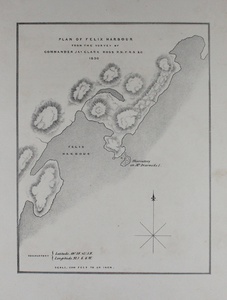| Method | Lithograph |
| Artist | after James Clark Ross |
| Published | [Printed by Graf & Soret, c. 1834] |
| Dimensions | 212 x 163 mm |
| Notes |
A plan of Felix Harbour, in a region known as the Arctic Archipelago or Canadian Arctic. From John Ross' "Narrative of a Second Voyage in Search of a Northwest Passage" published in 1834. James Clark Ross (1800-1862) was a British naval officer, who joined his uncle, Sir John Ross, on his second expedition to the Arctic and later went on his own expedition to Antarctica (1839-1843), travelling through Hobart, Tasmania, discovering Victoria Land and the Ross Sea, and exploring Graham Island. He was knighted upon his return to England in 1843 and published "A Voyage of Discovery and Research in the Southern and Antarctic Regions". Sir John Ross, CB, (24 June 1777 – 30 August 1856) was a Scottish rear admiral and Arctic explorer. Ross was the son of the Rev. Andrew Ross, minister of Inch, near Stranraer in Scotland. In 1786, aged only nine, he joined the Royal Navy as an apprentice. He served in the Mediterranean until 1789 and then in the English Channel. In 1808, he acted as a captain of the Swedish Navy and in 1812 became a Commander. He went on his first Arctic expedition in 1818, but he did not discover many new things during this voyage, as he and his crew were drawn of course by a mirage of mountains, which Ross named the "Croker Mountains". He left in May 1829 for a second expedition, this time on the Victory, a side-wheel steam ship. They sailed past Lancaster Sound to a previously unexplored area, where their ship became stuck in the ice. The crew was stranded for four years, during which they explored the regions to the west and north, with the help of local Inuit. On one of these explorations, Ross found the magnetic north pole on the Boothia Peninsula. In 1832, Ross and his crew abandoned their ship and walked to another shipwreck which had been abandoned by a different expedition many years earlier. A year went by before a break in the ice allowed them to leave, on that ship's longboats. They were eventually picked up by a British vessel and taken home. Ross went on a third and final Arctic voyage in 1850, searching for Sir John Franklin and his expedition party, which had been missing for four years. He failed to find Franklin and his crew, and after returning to England in 1851, he went back to Stranraer in Scotland to retire. He spent these last years of his life writing accounts of his travels and using his Scandinavian language skills to consult on political tensions in the Baltic. Ross died in 1856 while visiting London, where he is buried. Condition: Overall time toning and foxing. |
| Framing | unmounted |
| Price | £35.00 |
| Stock ID | 46998 |

